TIDINGS


AN ANNUAL COMMUNIQUÉ FROM THE MARIAN LIBRARY
INSIDE: Wayfinding in the Library
An Oak Anniversary
A Review of the Academic Year




AN ANNUAL COMMUNIQUÉ FROM THE MARIAN LIBRARY
INSIDE: Wayfinding in the Library
An Oak Anniversary
A Review of the Academic Year


As we celebrate the Marian Library’s 80th anniversary this October, I am grateful to those who came before, who envisioned, built and then stewarded a world-class collection to make Mary better known, loved and served. Although I only began my tenure as the director of the Marian Library this past May, I have worked here as an archivist and an assistant director since 2016 and am well-versed in the myriad ways my colleagues support learning and scholarship.
I have been busy this summer learning about the Marianist charism and family. Early in the summer, I participated in the Marianist Educational Associates (MEA) formation program with colleagues from the three Marianist universities: the University of Dayton, St. Mary’s University in San Antonio and Chaminade University in Honolulu. The MEA program was developed to ensure that Marianist universities sustain a strong Catholic and Marianist mission and identity. During the weeklong formation program, we learned of the founding of the Marianist family by Blessed William Joseph Chaminade, Marie Thérèse Charlotte de Lamourous and Blessed Adèle de Batz de Trenquelleon. We also discussed how we can each live and share the Marianist charism today through our varied roles on campus.
In July, I attended the continental assembly of the Marianist Lay Community of North America with University of Dayton religious studies professor Neomi De Anda, the first lay executive director of the International Marian Research Institute and a teacher, scholar and friend of the Marian Library. The theme for this year’s assembly was “Encounter, Embrace, Engage,” and Neomi and I, along with Caitlin Cipolla-McCulloch, a doctoral student in theology, presented a workshop on the ways that the Marian Library, IMRI and the religious studies department can provide programs and services for interested users.
The first Marian Library Newsletter was shared in 1944. It has grown into a robust annual publication filled with engaging stories that focus on efforts in the Marian Library — new additions to our collections, creative outreach and a look at successes and numbers from the past year. It has been reimagined to give you, the reader, a deeper connection with the Marian Library and a better understanding of its work since its founding 80 years ago by the Society of Mary at the University of Dayton. I am very excited to present Volume 1 — the inaugural issue of Tidings.
As the number of Marianist brothers, priests and sisters in the United States continues to decline, the University depends on lay Marianists and Marianist Educational Associates to sustain and grow UD’s Marianist character and values for generations to come. To that end, UD has launched an initiative called Forever Marianist to create and support opportunities to learn, lead and serve in the Marianist spirit. As Mary is central to the Marianist charism, the Marian Library will be involved in this important initiative.
I’ll end with wise words from my former colleague and director of the International Marian Research Institute, the late Father Francois Rossier, S.M. During his installation as director, he gave an address titled “Why Study Mary?” He said, “Ultimately we study Mary not in order to accumulate knowledge, but because knowing her leads to loving her. That was Blessed Chaminade’s experience. He invited the Marianists not only to know Mary, but also to love her, to serve her.” Through our collections, programs and services, the Marian Library will continue to help visitors know Mary.
Kayla

From providing food and shelter to offering materials for carving, framing, writing and bookbinding, oak trees are bound up with millennia of human culture, even though the classification of oak as an 80th anniversary gift is relatively recent, and though the world of oak trees extends far beyond humans.
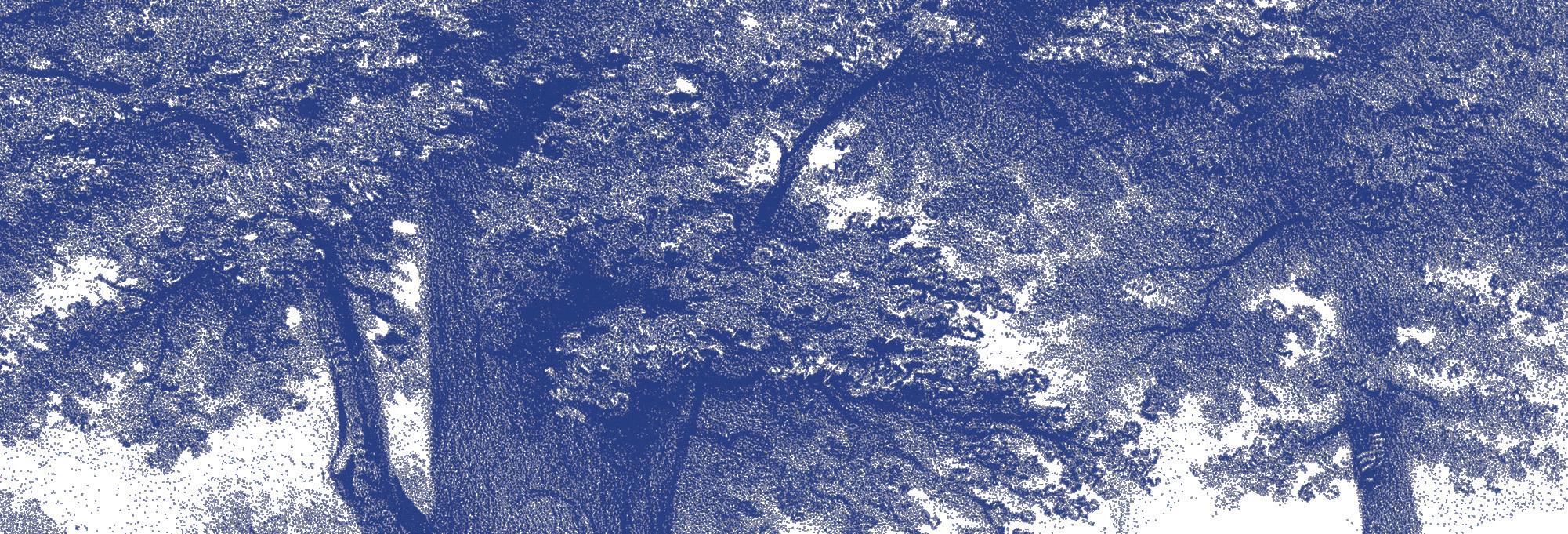
In Pilgrim at Tinker Creek, Annie Dillard wrote, “There are creatures under our feet, creatures that live over our heads, but trees live quite convincingly in the same filament of air we inhabit, and, in addition, they extend impressively in both directions, up and down, shearing rock and fanning air, doing their real business just out of reach.”1 Spend enough time in the Marian Library, and you’ll see trees almost everywhere.
Look out the window from the reading room, and you’ll see the trees populating Woodland Cemetery across Stewart Street. Wooden bookshelves, wooden frames for art, carvings (like “Our Lady of the Library”), rare books with wooden boards — the business of trees extends in many directions here.
Besides wooden items in the collections, oaks and other trees appear in supporting roles in stories and images. Mary appears in a holm oak — a European evergreen variety — in reports of Our Lady of Fatima, and more than one story of a miraculous image, like that of Nuestra Señora de Valvanera, begins in a tree. Statues, paintings and churches have
BY HENRY HANDLEYtaken on the name of Our Lady of the Oak in many places and languages: Notre-Dame du Chêne; Madonna della Quercia; la Virgen del Roble. It’s hard to say just how many instances there are where an inviting canopy and a local devotion grew together.
The 15th-century legend of Madonna della Quercia of Viterbo, Italy, says that after the painting was left beside an oak, the tree grew around it as a protector. During an outbreak of plague, Catholics sought protection and healing at the site, and devotion to Madonna della Quercia spread well beyond the sanctuary built in her honor, drawing pilgrims that included popes.
Devotion eventually reached a group of Catholic butchers in 16th-century Rome, who formed a Catholic church and confraternity and claimed the Madonna della Quercia as their patroness. A volume of the group’s records has been in the Marian Library since 1961, and it has a second connection to oak trees: The ink is made from oak galls and iron filings; it was one of the most popular formulas for ink in Europe for centuries because of its permanence.
Among manuscript invoices and lists, the records include printed forms with woodcut engravings of a portrait of Mary under a leafy canopy, Madonna della Quercia. The forms document one of the central charitable works of the confraternity: paying the dowries of impoverished women. The contracts stipulate the terms by which the confraternity’s
“So many human things are possible thanks to oak trees,”
— Former director Sarah Burke Cahalan on the Marian Library’s 80th anniversary
guardiani would pay — or ask to be repaid. The women are only known to us by name: Antonia Passolini, Appollonia Fracassi, Elisabeta Antonini, Teresa Filippucci, Maria Catarina Agostina, Anna Amici, Maria Schiavetti, Lucia Ferfendi, Marianna Sperga.
Although iron gall ink doesn’t damage oak trees, the oak tannins can corrode paper and parchment. In these records, the signatures of the guardiani bleed through the paper.

The Marian Library is not impervious to change — including climate change, which impacts everything from the long-term preservation of our collections to balancing work with caregiving during a tornado watch on a school day. Pope Francis has noted that Mary doesn’t stand apart from the world either. His encyclical Laudato si’ describes how “Mary, the Mother who cared for Jesus, now cares with maternal affection and pain for this wounded world” (241). More than presenting a singularly doom-laden, apocalyptic narrative, however, the encyclical invokes joy and love as part of an integral ecology.
The Marian Library responds to this call to caring for our common home in myriad ways, from participating in sustainability initiatives on campus to sharing resources that connect faith to the natural world through cultural heritage. As Pope Francis wrote, “Culture is more than what we have inherited from the past; it is also, and above all, a living, dynamic and
Depiction of the miraculous image of Our Lady of Good Help that appeared on the trunk of an oak in the Ardennes region of Northern France. French caption: “Représentation de l’image miraculeuse de Notre Dame de Bon Secours, Trouvée dans le Bois de Neuvisy sur le Tronc d’un Chêne le 30 Avril 1752 par des Enfants de l’endroit.”

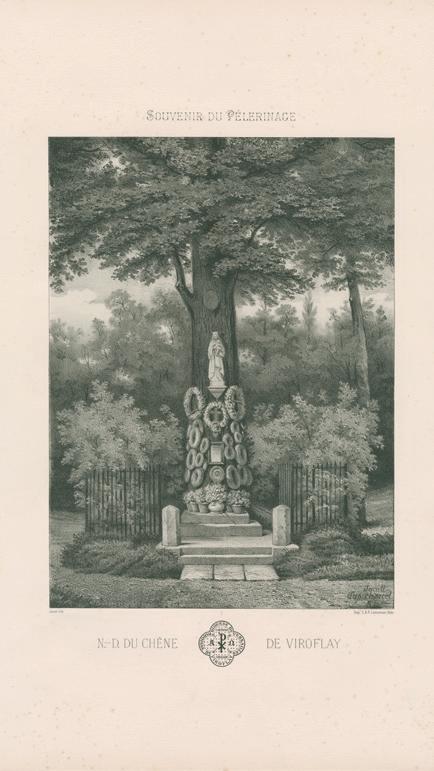
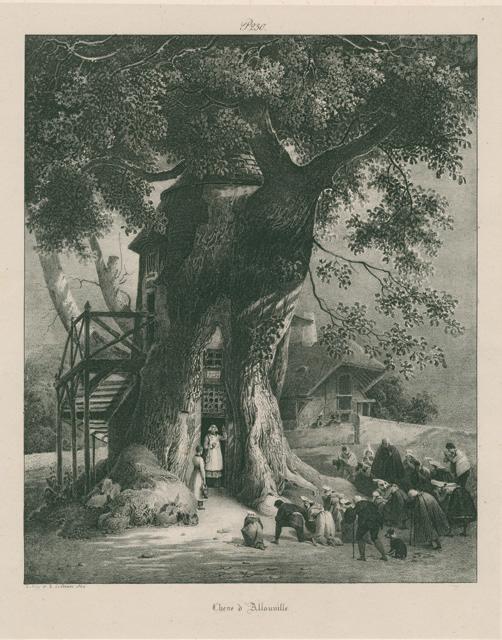
participatory present reality, which cannot be excluded as we rethink the relationship between human beings and the environment” (Laudato si’ 143).
Shrine to Our Lady of the Oak in Viroflay, France.
French caption: “Souvenir du Pelerinage, N.-D. du Chêne de Viroflay.”
‘OakPrints’ from the Clugnet Image Collection
While the Marian Library at 80 is in many ways an institution, it’s a living one, which fulfills the intentions of its founders as an anniversary gift itself. Marianists at the University of Dayton established the Marian Library to commemorate the triple centennial of their order’s arrival in the United States in 1849; the 1850 founding of what would become the University of Dayton; and the death of Marianist co-founder Blessed William Joseph Chaminade that same year.
Today the Marian Library connects to many lives: Marianists, of course, and Marian devotees from all walks of life, but also many authors, artists, printers, booksellers, librarians and readers whose work, physical or intellectual, intersects with the materials in our collections in some way. Beyond humanity, beyond oak wood and iron gall ink, the collections represent the lives of countless plants and animals, from the wood pulp that makes up the leaves of modern, mass-produced books to the animal hides transformed into parchment and leather in bookbindings.
Today these collections and networks continue to grow, and they can reach much farther thanks to the internet. On campus, the library has reached thousands of undergraduate students in the last year through class visits, student-curated exhibits and cocurricular programming.
What makes an oak tree or a library grow is invisible to the eye. It’s not something you can observe in an afternoon (though it’s well worth spending an afternoon with an oak tree or in a library). The perspectives and the efforts of everyone who has contributed to the Marian Library — student employees, directors, library colleagues in building services and cataloging — have supported its growth in the manner of concentric tree rings: sometimes invisible from the outside, tenuous in an emergency, but each just as integral to the life of the library.
— Henry Handley stewards the Marian Library’s rare, reference and circulating books, as well as its collection of periodicals and pamphlets.

and the
NOV. 20, 2023 – JAN. 12, 2024
go.udayton.edu/christmas-exhibit
This Christmas season, the Marian Library invites you to explore the intersection of Christmas and nature.


See Nativity sets, artwork and more through a different lens — plants, animals and the natural wonder of the world into which Christ was born.
COMING SPRING 2024
MARY IN CATHOLIC EDUCATION

udayton.edu/marianlibrary/exhibits

During a summer program on campus, high school students visited the Marian Library to explore their own faith and the Catholic Marianist tradition of the University through exhibits and collections.
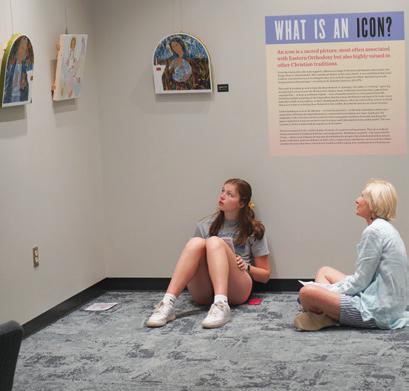


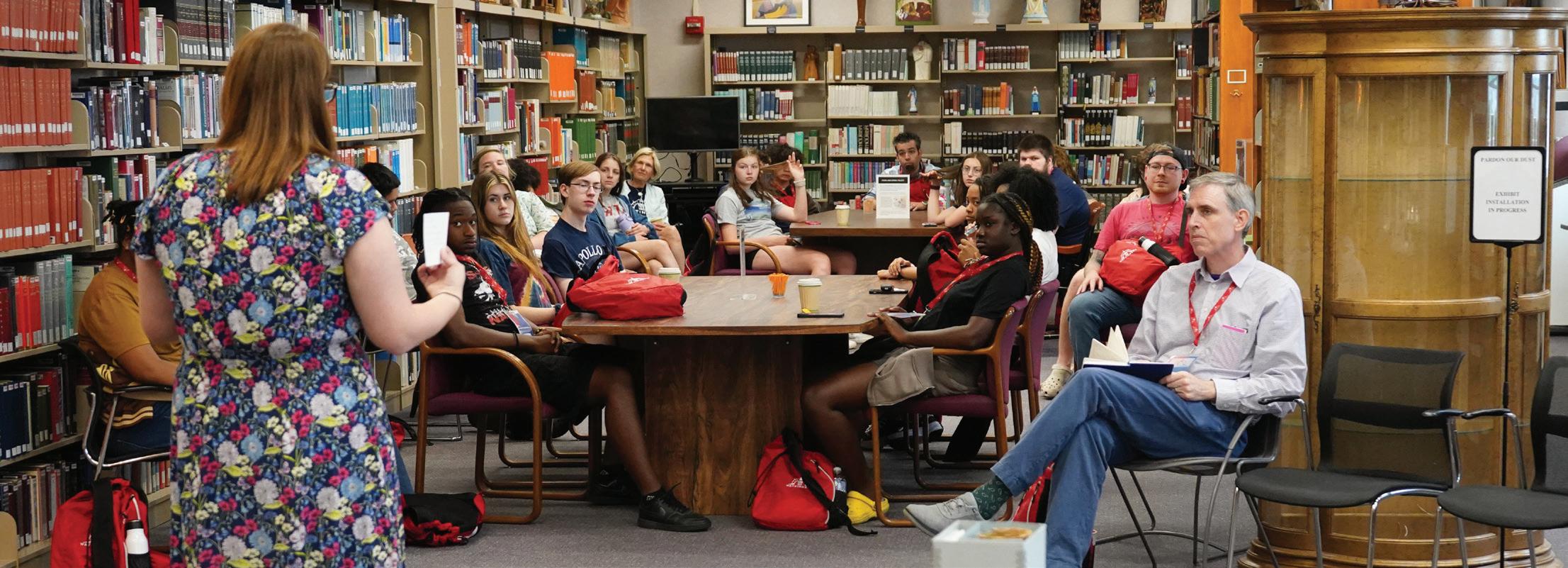
Faculty and graduate students in the religious studies department led the four-day Wayfinders program, which challenges high school students to engage with the question of what it means to be “on the way” in their lives — individually, with others and with God.
When the Wayfinders arrived in the Marian Library, director Kayla Harris gave a welcome and a brief introduction to the Marian Library, then passed two rosaries around the room — one scented with roses, the other made by a military chaplain at Guadalcanal in 1943 from paper clips and cowrie shells — as examples of the Marian Library’s collections and mission.
The participants explored the current exhibits on the seventh floor — East Meets West: Halyna Nykolyshyn’s Ukrainian Marian Legacy in the Marian Library Gallery and the Nativity sets on exhibit in the Crèche Museum. With a partner, each participant looked for pieces of information in the exhibits and reflected on cultural heritage preservation and family traditions.
Some students were particularly interested in Kevin Hanna’s “Mirror of Hope,” a large Nativity depicting the entire story of salvation, on permanent display in the Crèche Museum. Two participants reflected on this piece, “It’s very sculpted and encapsulates many of the Bible stories but keeps Jesus at the center.” Another remembered “Mirror of Hope” in their eval-
BY BRIDGET RETZLOFFuation of the entire Wayfinders program: “It was nice to see someone’s long hard work turn into something incredible, and each clay figure had a different thing going on.”
In the Rose Gallery on the first floor, participants took part in a guided meditation with the exhibit East Meets West: Women Icon Makers of West Ukraine Visual resources librarian Bridget Retzloff led a visio divina meditation in which participants looked deeply, reflected and prayed with one icon in the exhibit.
The group ended their time with the Marian Library by engaging with rare books. Collections librarian Henry Handley selected two rare books for each group to explore. After a brief introduction to handling rare books and using primary sources, participants were invited to “judge the books

by their covers.” They made observations about the external features of each book through the senses of sight, sound, touch, and smell (but not taste!). When each group opened the books, they made observations about the materials, condition and contents. Finally, they guessed why Handley paired those particular books.
One group made observations about a 1732 devotional and instructional book for English Catholics and a 1998 artist’s book with pages strung together like rosary beads. While from different centuries, these two books are connected by their intended use: in prayer and in devotion to Mary.
Of the visit to the Marian Library, Wayfinders director Tim Gabrielli, an associate professor in religious studies and Gudorf Chair in Catholic Intellectual Traditions, said that the activities were “all very much in tune with our thematic emphasis on ‘serene attentiveness’ and openness to the bigger questions in our lives.”
Serene attentiveness is an idea from the papal encyclical Laudato si’, in which Pope Francis invites Catholics to unite creation and redemption through careful attention to the world around them.
Marian Library staff and faculty appreciated the Wayfinders’ attentiveness and thoughtful reflection and hope they will find their way back as UD students, visitors or researchers.

When a celebrated artist came to the University of Dayton in February 2023 to receive the prestigious Marianist Award and present at the Marian Forum, his visit provided an opportunity shine a spotlight on works recently added to the collection and featured in the exhibit Rituals of Healing: Body, Mind, Spirit.
Brother Mickey McGrath, O.S.F.S., had displayed his work before in two exhibits at the Marian Library



— Hail Mary: The Tree of Life (1995) and Blessed Art
Thou: Mother, Lady, Mystic, Queen (2005). In the fall of 2022, the Marian Library acquired 46 of his works to its collection — 15 giclée prints and 31 prayer starter cards featuring colorful Madonna images. The new items added to McGrath works already in the collection — three giclée prints; six books he wrote


or illustrated; three holy cards; and three Christmas greeting cards.
McGrath is the first visual artist to receive the Marianist award, which the Office for Mission and Rector presents to Catholics who have made significant contributions to the Catholic intellectual tradition.
“Brother Mickey McGrath’s art making gives expression to his faith in the continued presence of Christ in our world,” said Sandra Yocum, University Professor of Faith and Culture. “His vivid and colorful images give witness to the beauty and wonder in our world, especially in the lives and works of holy people from Mary, the Mother of God, to Dorothy Day and Thea Bowman.”
During his visit to campus, McGrath toured the Marian Library and viewed items in its art collection. Additionally, he was able to see how students and staff displayed his artwork in the student-curated Rituals of Healing exhibit. He was particularly interested in learning how Marian Library staff catalog and store
two-dimensional art, and he expressed interest in returning to learn more about preserving and organizing his own artwork.
Learn more about McGrath and his work by visiting bromickeymcgrath.com.

— Michelle Schweickart is a library assistant in the Marian Library, working primarily with artwork, exhibits and special collections.
Brother Mickey McGrath, O.S.F.S., is an artist in the Oblates of St. Francis de Sales. His work has been featured in St. Anthony Messenger, USA Today and a variety of Catholic publications. McGrath also presents at retreats, schools and conferences on art’s ability to heal and strengthen one’s connection to faith. While on campus, he kept a full schedule of engagements and activities.
Marian Forum: “A Conversation with Mickey McGrath” — In a Q&A-style event, McGrath shared his thoughts on the role of art in the healing of communities, in keeping with the forum’s theme of physical and spiritual healing through ritual and belief. More than 200 people attended. The forum, presented by the Marian Library and other departments on campus, convenes annually to invite reflection about topics related to Mariology.
During the forum, a display case featured his works, including his newest book, Madonnas of Color; above it hung a print titled “Annunciation Quilt.” Nine original paintings, loaned to the Marian Library for the Marian Forum, were also on display.

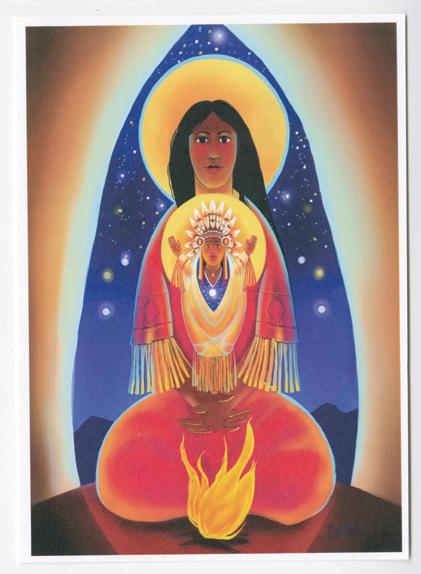
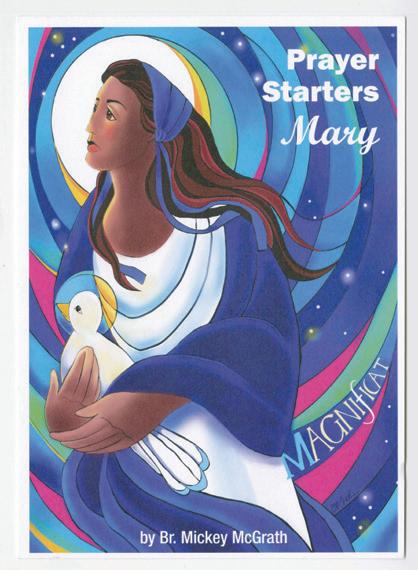
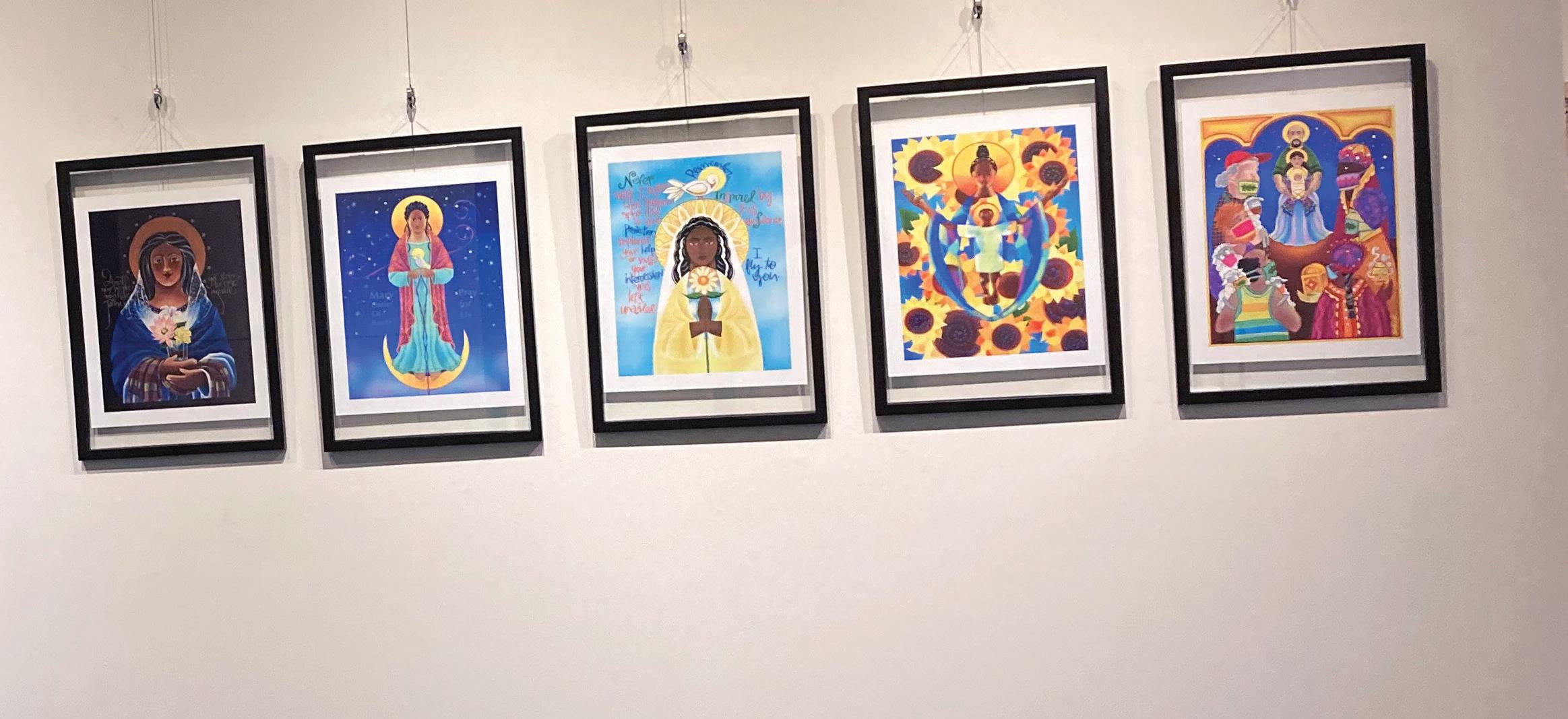
Marianist Award lecture and reception —

McGrath gave the lecture “Albert, Marian, and Me: How a Scientist, an Opera Singer, and a Houseplant Led Me to the Cosmic Christ.”
Campus mural project — McGrath designed “A Spectacle of Saints” for the Department of Art and Design and worked with University of Dayton staff and students to paint it.
“Brother Mickey McGrath’s art making gives expression to his faith in the continued presence of Christ in our world.”Sampling of prayer starter cards from the Marian Library’s collections.
Representing cross-cultural Marian connections, a fragile 200-year-old sketchbook with Japanese Buddhist origins has been selected for professional conservation. Created in the early 19th century by Tani Buncho (1763–c. 1840), a Japanese painter from Edo (now Tokyo), this accordion-fold album on mulberry (kozo) paper contains 32 ink drawings of the Goddess of Mercy, a popular divinity found among many Eastern religions. Known as Kannon, she is the Japanese adaptation of the Chinese goddess Guanyin.
Beneath the mold- and insect-damaged pages, delicate ink brushstrokes form elegant depictions of Kannon in various poses — sometimes even holding prayer beads that resemble a rosary. The Blessed Virgin Mary and Kannon share many spiritual qualities as archetypal mother figures who offer mercy and compassion to devotees. In a practice known as Maria Kannon, devotion to Mary was often disguised as devotion to Kannon — allowing Christians to practice their faith in secret during 250 years of persecution in Japan.

— Melanie Fields is a library specialist in the Marian Library, working primarily with artwork, exhibits and special collections while sharing information through a variety of media.
Photographer Oscar Rodriguez Zapata has been documenting Los Angeles street art of the Virgin Mary for the past 10 years. He shares this unique form of devotion — painted on the sides of bakeries, markets, tire stores and laundromats — on his Instagram account, @_lavirgencita. The Marian Library recently acquired four of his photographic prints.

For small-business owners in LA and the surrounding area, murals of Our Lady of Guadalupe (la Virgen de Guadalupe, also known as la virgencita), act as protection of their livelihood and an attempt to thwart vandalism. Zapata labels each image with cross streets to reference the location. In one image of Garcia Mini Market in LA’s South Park neighborhood, a wall is covered in graffiti, yet the image of Our Lady of Guadalupe is untouched. These murals risk erasure as neighborhoods gentrify and as retail chains replace family-owned businesses.
“Whenever you see a virgencita, you feel safe,” Zapata says. “You know that your people, your gente, your raza are around. It makes you feel welcome.” The images of Our Lady of Guadalupe signify community, and by acquiring these photographs, researchers and students can explore more about various forms of Marian devotion.

Fascinated by rare books, new books, all books — library items in general, Henry Handley is a master at noticing and delighting in the intricacies of the materials he stewards.
How long have you been working in the Marian Library? I’ve been at the Marian Library since July 2019, shortly after I completed my master’s degree in library and information science.
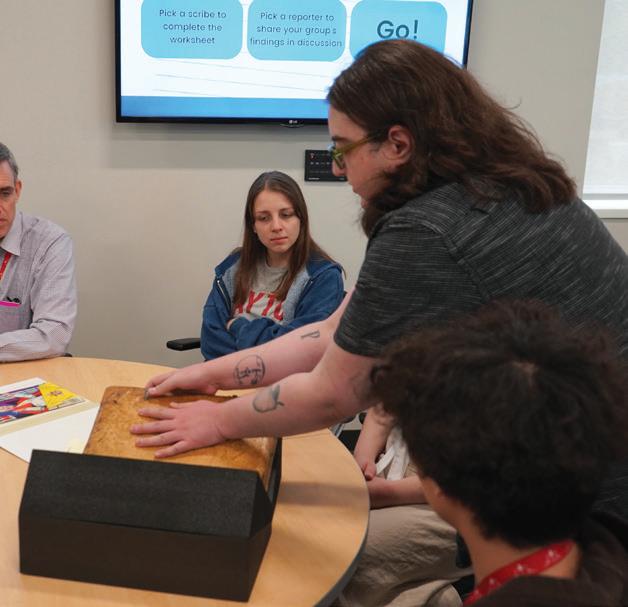
What was your introduction to rare books and special collections? When I was a college student, I worked in the campus fine arts library, but I was really anxious about taking up studying space myself. My adviser for a senior thesis, Saskia Hamilton, encouraged me to learn more about the publication of the poems I was writing about, including visiting an archival collection — which I did, and which was electric. I actually ended up working at the same archives during my MLIS.
What are some of your routine responsibilities in the Marian Library? In our Book a Librarian form, my assigned subject area is “Marian Library Published Materials,” which is the most succinct version! I’m responsible for collection development and management of over 100,000 books, periodicals and pamphlets in the Marian Library as well as reference and instruction using the collections. As a tenure-track librarian, I also have responsibilities in scholarship and service and have written several book chapters and articles related to the Marian Library’s collections and history.
What is one of the more interesting parts of your job here? I love browsing the antiquarian book market! Besides being lucky enough to have a budget
for new-to-us books, learning what’s out there keeps our collecting focus sharp and often leads to surprising connections.
If you were to pick one favorite item from the Marian Library’s collections, what would that item be? I have so many favorites, but the most permanent is an emblem book, a collection of illustrations and quips that represent morals or other instructive sayings. This example is a hybrid of plates from an incomplete emblem book printed in 1611 combined with dozens of miniature pen-and-ink emblem drawings. I have a tattoo of one of the bonus emblems and hope to spend more time researching the book someday.
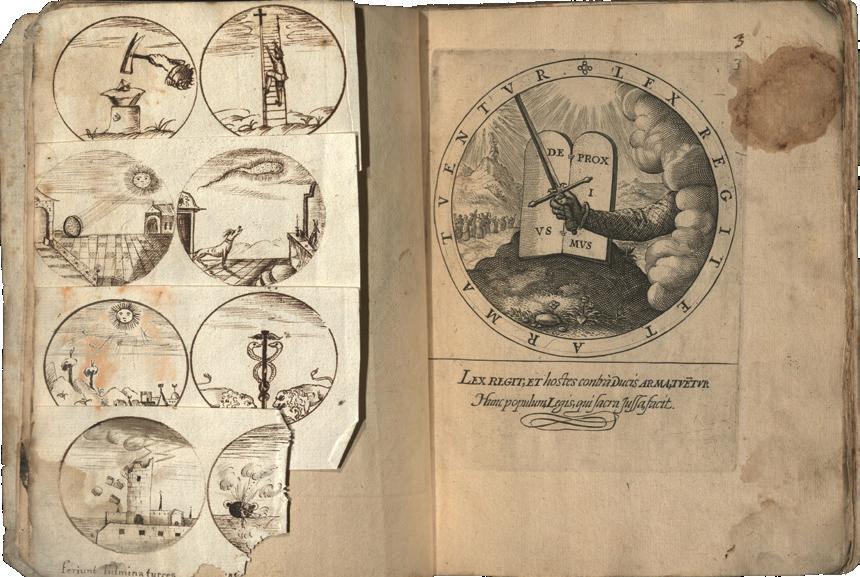
Beyond the Marian Library, what university or Dayton-area activities do you recommend? If the weather’s nice, a walk in Woodland Cemetery next to campus — but Bill’s Donuts is open 24/7 for good (even delicious) reasons!
What is your favorite board game? My family’s go-to vacation board game is Clue, which combines things I’m good at — organizing information — with things I’m less good at — like remembering exactly why I walked into a room.
The Marian Library has been referred to as a “hidden gem.” It is definitely a gem, but hidden is not what we are going for.
The Marian Library openly invites the campus community and the public to step off the elevator onto the seventh floor of Roesch Library. Until recently, that initial step for first-time visitors could be confusing due to lack of branding of public spaces and clear distinction between public and staff spaces. Inspired by renovations in other Roesch Library areas, discussions and wayfinding exercises were conducted to identify barriers and create solutions to make the Marian Library easier for visitors to navigate.
Problem 1: No identifiers. The first order of business was to assure visitors that when those elevator doors opened, they were in the right place.
Solution: A three-dimensional Marian Library logo, along with the motto “De Maria numquam satis — Never enough about Mary,” in a brushed nickel finish, was installed on the wall across from the elevators. It gives a well-deserved, distinguished nod to the 80-year-old library. A new plexiglass frame installed on the same wall now provides a place for directions and information about exhibits and events.

Problem 2: Where is the gallery? Where is the Crèche Museum? Where is the reading room? The gallery entrance off the main hallway isn’t always obvious to visitors. The Crèche Museum and the reading room are both tucked away from immediate view.
Solution: More 3D brushed nickel! “Marian Library Gallery” lettering was added to an interior wall to be visible through the gallery windows as visitors walk down the hall. The Crèche Museum also gained some new brushed-nickel lettering. To bring attention to
the entrances of the reading room and the Crèche Museum, each was framed in dark gray with large, white lettering above.

Problem 3: Where does the public space end and the work space begin?
The ‘No Signage’ Solution: Several pieces of artwork had been on display down the hallway walls from the reading room past the Crèche Museum and continued through the staff office hallways. It was tempting to any visitor to just keep going and looking at the art, not realizing that they had ventured into a staff work area. Part one of the solution was to remove the artwork in the office hallways. Part two was to paint the walls near the office space a different color, creating a visual cue for visitors. This solution provided the added bonus of brightening up hallways that were feeling dated and dim.
The next time you visit the Marian Library or bring a guest who’s never visited before, let us know if our enhancements are working. We are always open to suggestions from our patrons.
— Ann Zlotnik is a graphic designer and the communication and creative coordinator in the Marian Library.
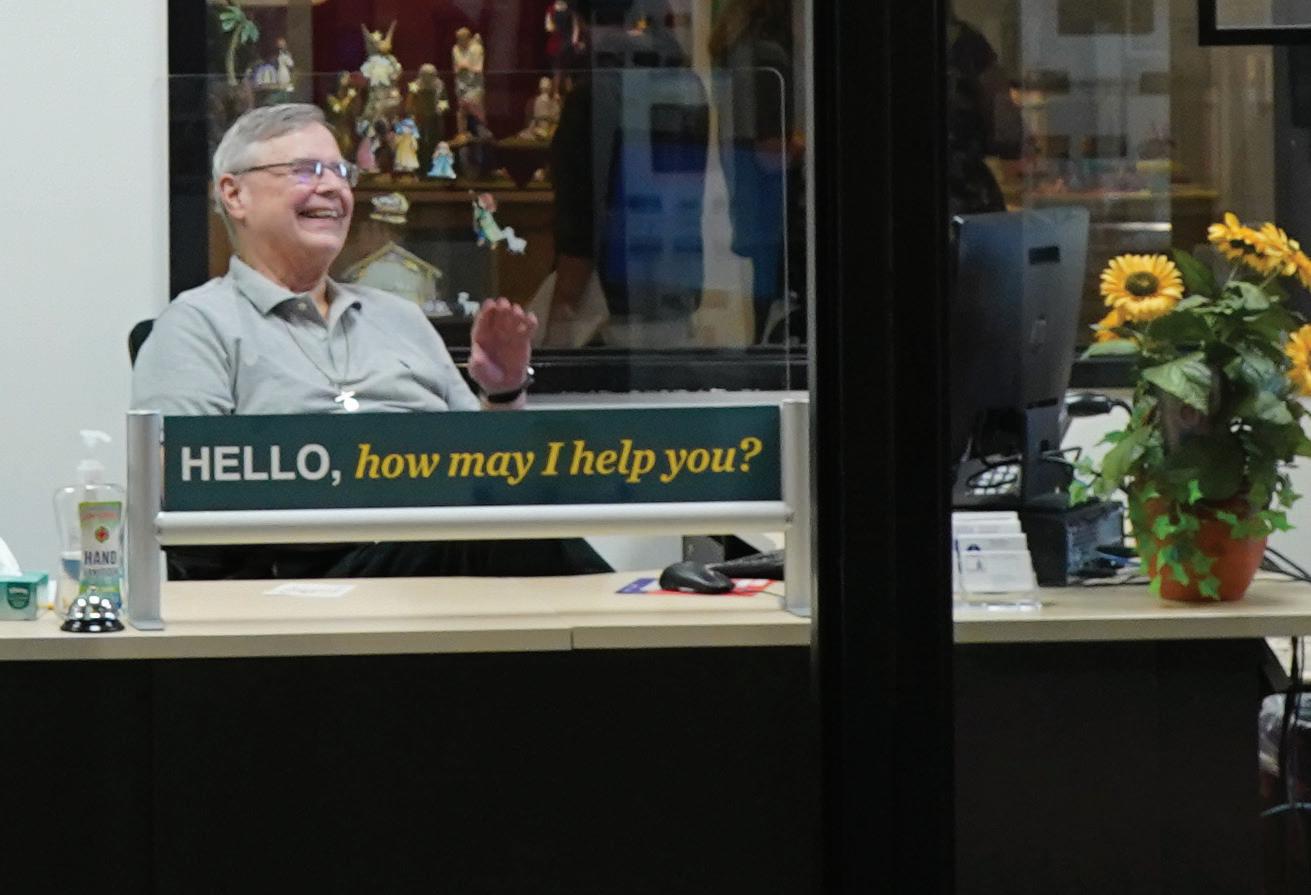
The Marian Library is central to the University of Dayton’s Catholic and Marianist identity. This past year, we undertook many initiatives to engage existing and new audiences with our unique cultural heritage materials. Through collections, outreach, instruction and programming, we continue to serve the research needs of faculty and students of the University of Dayton and visitors worldwide. For 80 years we have helped others know Mary.
Timely, Unique and Strategic Additions
• Ukrainian art by current working artists to revitalize the Ukrainian Marian Collection.
• Pieces by Brother Mickey McGrath, O.S.F.S. (see Page 8).
• Marian materials related to healing and disability.
• El altar in el jardín (The Altar in the Garden) artist book by Marina Soria.
Conservation Projects
• Work completed on a Marian statue as well as a 1638 New Testament Bible.
• Initial assessment completed and project underway to conserve 32 drawings depicting the Buddhist divinity of mercy.
INSTRUCTION:
34 classes taught with 608 students in attendance
COCURRICULAR PROGRAMS:
7 programs for housing points; 4,820 students participated
Liz Grauel completed her mini-practicum at Dominican University through an internship in the Marian Library. She processed several collections, including Lourdes Medical Bureau case files and reports.
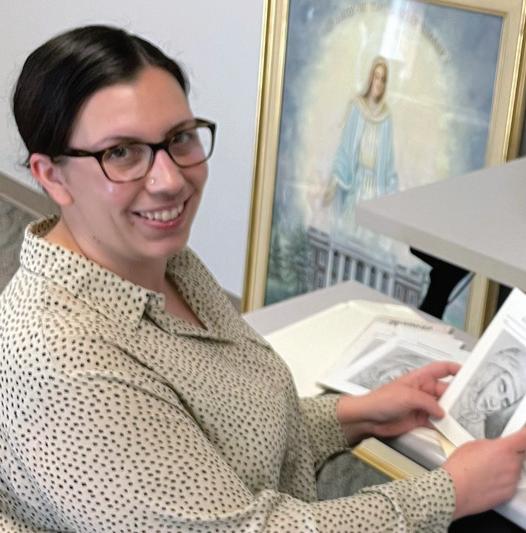
1 exhibit curated by first-year writing students; 2 programs created by teacher education students featured in the Juggling for Mary exhibit; 9 students employed at the Marian Library
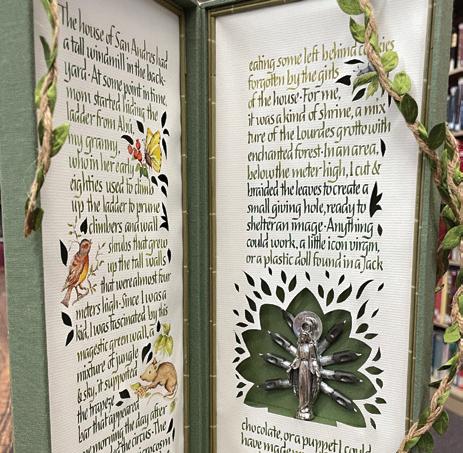





A Vision of Art and Faith: The Litany of Loreto and the Work of Ezio Anichini (1886-1948)

April 4 — Aug. 26, 2022
A Living Library: Marian Acquisitions through 2022
Sept. 6 — Oct. 28, 2022
Juggling for Mary: Vocation, Gifts and Performing for Our Lady


Nov. 7, 2022 — Jan. 27, 2023
Rituals of Healing: Body, Mind, Spirit
Feb. 8 — April 20, 2023
East Meets West: Women Icon Makers of West Ukraine
May 1 — June 30, 2023
Halyna Nykolyshyn’s Ukrainian Marian Legacy
May 1 — Nov. 10, 2023
Events were free and open to the public.
• Juggling and acrobatic performances.

• Read-aloud story times led by teacher education students for visiting school groups.


• Campuswide story walk created by students using Tomie dePaola’s Clown of God.

• Commission of Barnaby’s Gift, a new musical composition and performance by UD faculty members, supported by donors.
• Stuart and Mimi Rose Gallery used for A Simple Gift performance by student and faculty ensemble.
• Guest lecture by Jan Ziolkowski, Harvard University.
A community engagement event in conjunction with the East Meets West exhibit; Hall is a Kettering City Council member and active in the greater Dayton Ukrainian community.
To learn about other donor-supported projects and how you can help the Marian Library, see go.udayton.edu/marian-library-give


Jack Mulder, philosophy professor and philosophy department chair at Hope College, was awarded the Marian Library Visiting Scholar Fellowship for his project on Marian philosophical theology. Mulder spent two weeks in the Marian Library conducting research on the nature of icons such as the tilma St. Juan Diego wore when the Blessed Mother appeared to him in 1531; the image of Our Lady of Guadalupe is said to have miraculously appeared on it after her visitation. He then turned to another set of research questions, including the theology of Marian consecration by St. Maximilian Kolbe and St. Louis de Montfort.
Hsuan Tsen, a senior lecturer in the Department of Art and Design at the University of Dayton, was awarded the Marian Library Resident Scholar Fellowship to continue research on visual exchanges between Japan and the United States in the late 19th and early 20th centuries. Her research explores the work artist John La Farge produced following a trip to Japan in 1886. In the Marian Library, Tsen researched representations of the bodhisattva Kannon (such as the album featured on Page 10) and the ways in which these depictions were influenced by — or even merged with — images of Mary.


A collaboration between campus partners resulted in this two-part forum that focused on the Blessed Virgin Mary with regard to healing physically and spiritually through rituals and miracles, as well as the healing of communities.

• Exploring Disability, Spirituality and Community at Lourdes Sanctuary, by Liz Hutter, 2022 Marian Library Fellow


• A Conversation with Mickey McGrath
Mary-Kate Sableski, an associate professor in the Department of Teacher Education, is a researcherin-residence during the 2023-24 academic year. Sableski is working with the Marian Library’s juvenile collection to explore how Catholic children’s literature, specifically literature depicting Mary, can be utilized in today’s classrooms in Catholic schools.
300 College Park, Dayton, Ohio 45469-1390 937-229-4214
marianlibrary@udayton.edu udayton.edu/marianlibrary
EDITOR: Kayla Harris
ASSISTANT EDITOR/GRAPHIC DESIGN: Ann Zlotnik

EDITORIAL SUPPORT: Maureen Schlangen
PHOTOGRAPHY/DIGITIZATION: Ryan O’Grady, Kennedy Kish ’24
CONTRIBUTORS: Melanie Fields, Henry Handley, Bridget Retzloff and Michelle Schweickart

READ OUR BLOG udayton.edu/blogs/marianlibrary
Over 35,000 views, 49 blog posts by 17 authors, including 4 student employees, 2 fellows and 5 Marian Library colleagues.
 VOLUME 1 • 2023
Cover art: Our Lady, Untier of Knots (detail) by Brother Mickey McGrath, O.S.F.S.
Mural of Our Lady of Guadalupe at South Gate Meat Market, Martin Luther King Jr. Boulevard and San Jose Avenue, South Gate neighborhood of Los Angeles (see Page 10)
VOLUME 1 • 2023
Cover art: Our Lady, Untier of Knots (detail) by Brother Mickey McGrath, O.S.F.S.
Mural of Our Lady of Guadalupe at South Gate Meat Market, Martin Luther King Jr. Boulevard and San Jose Avenue, South Gate neighborhood of Los Angeles (see Page 10)